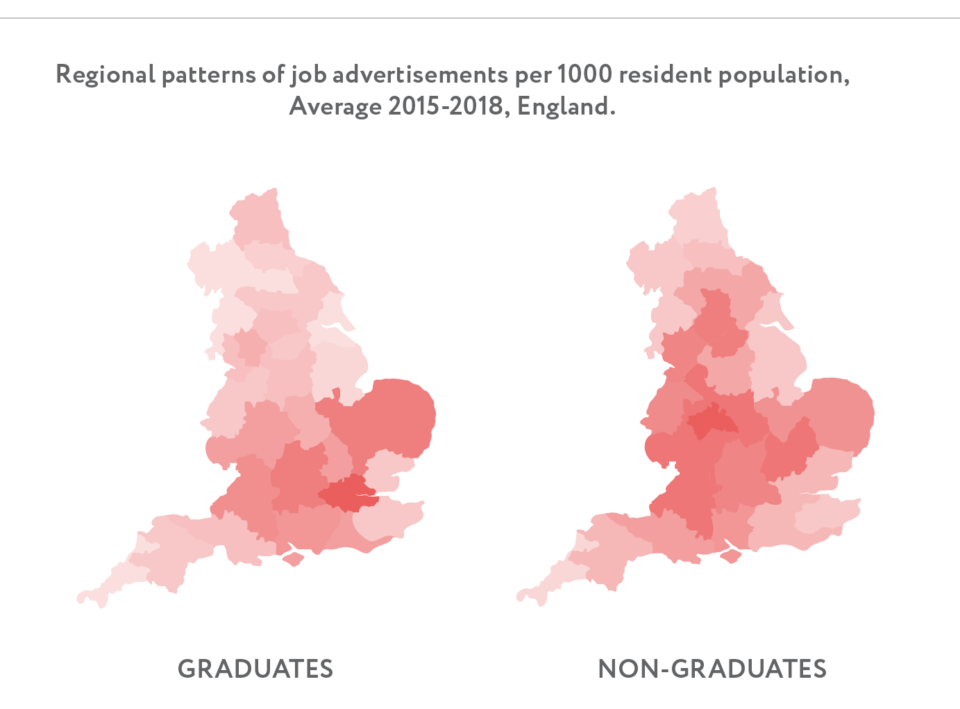How can education and skills policy in England boost productivity?
Education policy typically focuses on how young people can amass more skills that employers might then use. But with national productivity growth still underperforming, it may be more effective to think about what training is needed and how organisations can make better use of the skills on offer. This blog was written by Professor Andrew Westwood, based on insights from his work in The Productivity Agenda report.
There is widespread political and economic agreement that the education and skills of the country’s workforce make an important contribution to productivity growth and to improved living standards.
This belief in the importance of human capital has long underpinned the education policy of successive UK governments, including the significant expansions of the higher education sector in 1992, 1997 and 2013.
It has also informed reforms of vocational education and training – particularly in England, where there have been more frequent reforms of institutions, qualifications and work-based training, including apprenticeships.
But this broad consensus has tended to fall apart when it comes to delivering specific education and skills policies – whether it be sectors or places, supporting different kinds of institutions, policies or reforms. Perhaps most controversially, this also applies to decisions around how policies are funded and who should pay for them.
Further, despite the ambitions behind many reforms over the past two decades, stagnating productivity, wages and living standards – especially since the global financial crisis of 2007-09 – have cast doubt on the effectiveness of human capital and weakened the consensus about its importance.
Switching the focus from supply to demand
Discussions of these policies have typically focused on the supply side – how more skills and qualifications can be amassed for employers and organisations to then deploy as they see fit.
But with employers’ needs changing, and varying across the UK, research from The Productivity Institute demonstrates that the UK’s policy architecture is inadequate for a high-productivity, high-skill growth model. Indeed, it is beset by skill mismatches, regional disparities, underinvestment, policy churn and policy fragmentation.
Focusing solely on the supply of skills overlooks the importance of what kinds of skills employers are looking for on the demand side, particularly given regional differences and technological change.
The assumption that higher education credentials and skills necessarily make for more productive workers earning higher wages has also been called into question. The preoccupation with the supply of skills also sits uneasily with these recent commentaries and empirical evidence.
The UK faces significant challenges in building a more effective framework for public policy and employer practice. But this is needed in order to raise productivity and living standards, and to ensure that economic opportunities are fit for people’s aspirations at work.
To do so, the demand side of the labour market – the choices and actions of employers – also needs to be better understood if the UK is to develop a virtuous circle between skills, productivity and living standards. This argument is set out in the recent The Productivity Agenda report.
Employer-generated labour market demand
Recent research from The Productivity Institute focuses on the employer as a key architect in constructing labour market demand. This includes the decisions that organisations make about where to locate graduate jobs and high-tech positions, as well as whether to hire from an online pool of freelancers rather than recruiting traditional employees.
New digital technologies seem to offer organisations opportunities to raise productivity by recruiting high-skill tech workers (such as developers, data scientists and digital engineers).
Further, many companies are now deploying digital technologies to construct a ‘blended workforce’ of in-house workers and crowd-sourced freelancers to improve productivity. This trend raises questions about the incentives and commitment of employers to the provision of training and career pathways for their employees.
Regional disparities in skills
There are also major regional imbalances in skills and the returns to graduate education (Stansbury et al, 2023 and Burn-Murdoch, Financial Times).
This is in part because high-paid employment opportunities for graduates in poorer parts of the UK are relatively scarce, leading to regional ‘brain drain’ to London and the South East. This trend further reduces already scarce human capital and means that the graduates who remain are more likely to work in low-paid and non-graduate jobs.

Figure 1: Demand for high technical skills, graduates and non-graduates. Source: Author’s calculations using Lightcast data. Note: The darker the colour, the greater the demand relative to population in a region.
Government intervention in both the economy and spatial policy is changing. Both industrial and regional policy are becoming increasingly significant both domestically and internationally. This has been spurred by the Inflation Reduction Act (IRA) and the CHIPS and Science Act in the United States, and by geopolitical tensions and uncertainties related to energy and the transition to net-zero carbon emissions.
The Labour Party – which currently has a strong chance of forming the next UK government – is committed both to a modern industrial strategy and to more radical devolution. The Conservatives too have been pursuing their own levelling-up agenda and, as the 2023 Autumn Statement demonstrated, a series of manufacturing and clean energy strategies, including support for new electric vehicle and battery plants in Somerset and Sunderland.
All change
We have, of course, been here before – although in the UK, we’ve been pretty much everywhere before. Indeed, one major cause of our current economic failure is our chronic inability to stick to anything for very long.
Policies – especially regional and industrial ones, as well as those related to skills and human capital – are constantly subject to chopping and changing. So too are the ministers, departments and agencies overseeing them.
According to a 2017 report from the Institute for Government (IfG), since the early 1980s, there have been 28 major pieces of legislation related to vocational, further education and skills training; six different ministerial departments with overall responsibility for education; and 48 secretaries of state with relevant responsibilities. Further, no organisation has survived for longer than a decade.
Gillian Keegan, herself a former skills minister in 2020-21, is the eighth secretary of state at the Department for Education (DfE), since the report was written.
The landscape in the UK has been described as ‘a set of institutions, funding mechanisms and levels, inspection regimes, regulatory arrangements, programmes, qualifications, assessment systems, and policies that are in constant flux’ (Keep et al, 2021).
The 2017 IfG report also picked out further education, alongside industrial and regional policy, as policy areas most subject to constant chopping and changing of approaches and short-termism. In the report, Philip Collins describes further education and skills policy as ‘the worst failure of domestic British public policy since the Second World War’.
Counterproductive and incoherent systems
In England, schools, skills training and universities are all run in very different and often competing and counterproductive ways. There are coordination problems within the DfE, but also with other departments and policy agendas that are vital to improving productivity.
As Frank Coffield (University College London) has argued, England does not have a single, coherent educational system: instead, it has three badly coordinated sectors, like ‘three well-intentioned but dyspraxic and myopic elephants, who are constantly bumping into each other and standing on each other’s feet’.
Higher education has been treated as a market, shaped by student choice and overseen by a regulator, the Office for Students (OfS). Student numbers are uncapped and institutional funding comes through the student loan system.
Further education, on the other hand, has strict number controls and budgets. Contracts are managed more directly by agencies based in the DfE. Universities are independent organisations with a high degree of autonomy, but colleges are now part of the public sector and exist with very little discretion over spending, qualifications or provision.
Apprenticeship policy is different again – funded through an employer levy and overseen by a different regulatory regime.
In England, there is no joined-up approach that looks at how these different elements come together. This sits in contrast to the integrated tertiary systems now emerging in both Scotland and Wales, as well as in countries like Ireland.
Funding challenges across the education landscape in England
There are also increasing funding challenges across all parts of the English ‘system’. Arguably, further education and adults in learning have suffered the most from this.
According to the Institute for Fiscal Studies (IFS), between 2010/11 and 2019/20, spending per student aged 16-18 fell by 14% in real terms, leaving spending per student at around the level it was in 2004/05.
Over a similar period in England, total adult skills spending in 2024/25 will be 23% below 2009/10 levels, while spending on classroom-based adult education will be more than 40% lower.
Figure 2: Spending per pupil/student per year at different stages of education (2023/24 prices). Source: HM Treasury, GDP deflators, November 2023. Note: Early years figures are spending per child for 3- and 4- year-olds taking up a place. Secondary spending per pupil includes spending on school sixth forms. Further education figures represent spending per student aged 16-18 in further education and sixth form colleges. Higher education figures are cohort-based numbers divided by three – an approximate course length. In higher education, the £9,000 tuition fee has only been updated for inflation once since its introduction in 2012. This means that it is only worth around £6,000 today.
In a recent report from the House of Lords, the higher education sector was described as facing ‘a looming crisis’. It further declared that the ‘current system of funding higher education is not sustainable’. The latest figures for 2021 show that an unprecedented 100 of the 144 higher education institutions reported a deficit in the previous year.
What should be done?
For both employers and individuals, more incentives are required to tackle declining levels of investment in training.
This could include the extension of full expensing for businesses to provide training or offering more generous tax credits or personal allowances.
There will also need to be a clearer-eyed assessment of the role of employers in driving the skills system – it will provide little benefit if they are drawn from the many low-productivity sectors and places that make up the UK economy.
More coherence for employers and individuals, as well as better integration across the different sectors in England, is needed. For example, a tertiary approach where the different parts of the system fit together better and where funding and entitlements are consistent across types of learning, age and institution would bring improvements.
There will also need to be improved coordination with other policy areas related to growth and productivity, including those for broader economic and industrial strategy, research and development, innovation, and local and regional policy.
Part of this should involve greater powers for places and regions to determine the shape of the system and a move away from a ‘one-size-fits-all’ approach (because in England’s unequal economic and industrial geography, one size doesn’t fit all).
The coming general election will take place against a backdrop of constrained public spending, caused in part by the country’s poor recent record on growth and productivity. It will take a significant shift in our approach to develop a long-term education and skills policy. This will require investment and sustainable funding for all parts of the system.
The investment will need to come not just from government, but from employers too. At present, the amount that employers invest in training compares very poorly with other countries and it has been in long-term decline.
Lastly, a sustainable solution to the collective problem of training and skill gaps requires dialogue with trade unions too, drawing on their industry- and region-specific knowhow.
Whichever party wins the next general election may be able to start the next parliament with the systems and the funding that are currently in place – but it is highly unlikely that these can remain intact by its end. Certainly not if we wish to maximise the links between education, training and productivity, pay and living standards.
This blog was first published by Economics Observatory where a list of further reading and experts can also be found.




